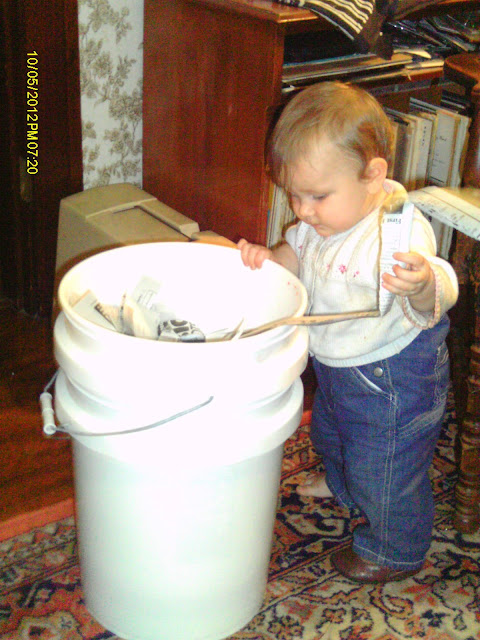 |
| Introduction to Vermiculture (or composting with worms!) |
Time to build a worm bin! No more excuses of not being able to compost because you don't have a backyard. Even ten month old babies can have a hand at vermicomposting. It's time to partner up with the redworms!
Here's the basics on vermicomposting.
Best worm: Eisenia fetida (redworm)
-you can order them online, or get them from a vermicomposting friend
-Redworms do well with heat, reproduce well, can live as long as 4 years, and naturally live in the organic matter layer of soil- aka- leaf layers, manure, etc.
-different than earthworms or nightcrawlers (they live deeper in the soil and work to dig up and mix the soil rather than break down the top layer)
Basic Worm Bin Ingredients
-container
-bedding
-moisture
-worms
Finding the Right Container
You can use any container: buckets, plastic tuperware, etc. It is useful to have two layers of containers so that the bottom can collect any drainage from the compost. You just need to make sure you have enough space for the worms and enough air circulation inside the container.
As for space- you can use this equation to figure out how much space you need for how many worms you have:
+First find the AREA (LxWxH) of the bottom of the container
[note, for a round bucket, A: (pie)r squared and r=c/2pie]
+When you have the square footage figured out, you can figure this ratio:
1 lb of worms require 1 sq ft of surface
As for circulation, it is important to add holes in the container to create lots of air flow.
 |
| Using a drill, I drilled in lots of holes into the lid, sides and bottom of the top bucket layer. |
 |
| When drilling, I left 6-10" of the top layer bucket bottom sides without any holes, as to keep the area where the compost will without any holes. |
Making the worms a Bed
Shredded newspaper, leaves, shredded cardboard, a little soil- whatever you chose, they will all suffice for bedding purpose.
The worm bin needs to be about 2/3 Full of Bedding.
And the Moisture of the bedding should equal that of worms, which is 75-90% wet.
 |
| Rosemary working with the newspaper bedding. |
WORM FOOD!
Here is a basic working list:
GOOD for worms
Tea & tea bags
Coffee Grounds & non-bleached filters
Vegetables (except onion skins & garlic)
Fruit (go easy on the citrus)
egg shells (the worms like to lay their eggs in them!)
BAD for worm
meat
oil
pet waste
non-biodegradables: plastic, foil, glass, etc (duh!)
And HOW MUCH TO FEED THEM?
The amount of worms you have will depend how much to feed them, and of course, worms reproduce quite well- so this estimate will change as the months pass, so it's important to monitor as things go along.
Here's a general ratio:
1 # of worms process 1/2# of food/day (3.5# per week)
Worms:Garbage = 2:1
So, if you are using a double pickle-bucket system like seen here, it has about an area of 1 sq ft, which can hold about 1 lb of worms- so it eats about 1/2 lb of food scraps per day - or 3 1/2 lbs of food scraps per week.
Troubleshooting & Harvesting
Finally, caring for a worm bin will require some level of checking in on them to make sure the wormies are happy, well-fed, and doing what they're needed to do. Issues may arise, like odor, or fruit flies, or worm death - BUT HAVE NO FEAR! There are solutions!
This webpage of the NYC Compost (for lots of people with no land indoor composting!) is a useful troubleshooting resource: http://www.nyc.gov/html/nycwasteless/html/compost/edu_indoor_problems.shtml
On that link there are also resources for harvesting the incredibly beneficial worm castings so you can put them on your plants and in your garden!
ONE LAST NOTE:
I hope that vermicomposting is as fun for you as it is fun for us! We like to open the bucket daily and check out the worms- Rosemary is very interested. We also keep a separate compost bucket to go outside & a chicken scrap bucket- so food scraps are getting specifically allocated over here!
I was lucky enough to be given worms & an info session from the OSU (Ohio State University Extension) "Cuyahoga Composts" program that had 6 sessions. It was their pilot class for this topic, and they plan to have them in the future. If you are interested in the future "Cuyahoga Composts" classes, you can check out their website http://cuyahoga.osu.edu/ or email Nicole Wright at wright.1128@osu.edu for more info.
I didn't mention where you can purchase worms from, but if you do a quick search online, you will be sure to find something. Also, if you are in the Cleveland area, there is someone who is currently working to set up a Complete Worm Composting System called "Tidy Worms" for sale. If you are interested- contact Ryan at ryandebiase@gmail.com
Happy Worm Casting Hunting!
No comments:
Post a Comment